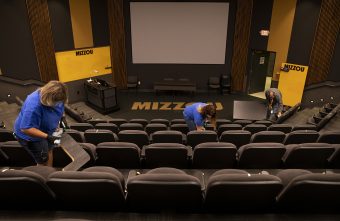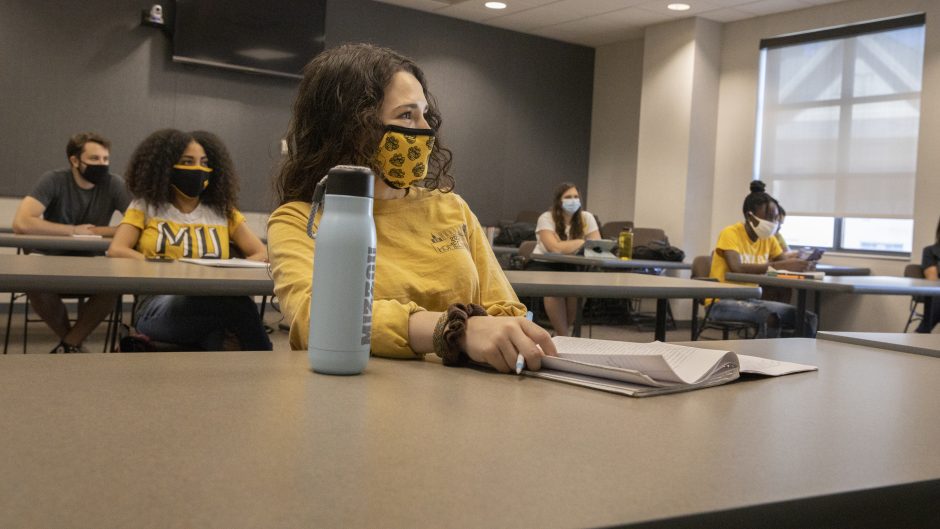Aug. 27, 2020
Contact: Liz McCune, 573-882-6212, mccunee@missouri.edu
While the COVID-19 pandemic forced Mizzou to end its 2020 spring semester with classes online, university officials were already planning for the future of learning at Mizzou – even if that meant continuing to face a global pandemic. Under the leadership of UM System President and MU Chancellor Mun Y. Choi, a team of more than 130 people — including a public health expert who also served on Missouri’s statewide medical advisory team — strategized and planned for the future. It took several months to develop the university’s plan — known as Show Me Renewal.
The plan is split into seven different focus areas — academic; research; student affairs; testing, tracing and quarantining; communication; facilities; and athletics.
Monitoring to control the spread
"Viruses like SARS-CoV-2, which causes the COVID-19 disease, need a host to replicate, so they typically spread from person to person through respiratory droplets or airborne transmission," said John Middleton, a professor in the MU College of Veterinary Medicine who also serves on the executive team of the Show Me Renewal Plan.
“Therefore, in the case of COVID-19, we are finding virus transmission usually occurs with prolonged close contact, which means someone is within 6 feet or more of an infected person for 15 minutes or more,” said Middleton, who is also chair of the MU Faculty Council.
In line with guidance from the Centers for Disease Control and Prevention on reopening college campuses and schools, and guidance from the American Medical Association, MU has developed a COVID-19 testing strategy focusing on symptomatic individuals. MU has the capacity to test any student who shows symptoms of COVID-19. Individuals will receive a polymerase chain reaction test, or PCR test, and possibly an additional antibody test. However, testing plays just one small part in controlling the spread of the virus.
“Practicing 6-foot social distancing, the use of face coverings and an emphasis on hand hygiene are the most effective tools at our disposal for reducing the spread of the virus,” Middleton said. “By testing symptomatic individuals, we can identify those most likely to be shedding high doses of virus contributing to disease spread while avoiding using up valuable testing resources needed for critically important medical situations.”
Steve Whitt, the chief medical officer for MU Health Care, said the reliance on testing misses a significant number of infected individuals and identifies some as infected who are not.
“The safest and most proven method of preventing contraction of COVID is to follow our well-established public health measures, which we are doing in all of our campus facilities,” Whitt said.
Whitt serves on the Missouri governor’s medical advisory group and participates in regular meetings with the governor and his staff to discuss the state’s COVID-19 response.
Importance of contact tracing
The plan’s testing, tracing and quarantining work group is collaborating with local and state health departments to conduct case investigation and contact tracing, or determining who might have come in close contact with a person having the virus.
Prior to MU, Lynelle Phillips worked for the CDC in areas such as environmental health, immunization and tuberculosis control. Over the summer, Phillips, a professor in the MU School of Health Professions and a member of the plan’s contact tracing workgroup, worked with some of her students to volunteer with Columbia/Boone County Public Health and Human Services to assist with local COVID-19 case investigations.
“From an epidemiology perspective, reacting quickly to identify any close contacts of an infected individual and the ability to quarantine them will help reduce the transmission of the virus,” Phillips said. “MU has taken a very thoughtful approach to how we are returning to campus life, including providing isolation and quarantine housing to infected and exposed students and spacing out the seating in classrooms so that classmates are not considered close contacts of an infected individual.”
MU recently hired a total of 20 people to work as either case investigators or contact tracers to supplement the Columbia/Boone County Public Health and Human Services case investigation and contract tracing team.
Collaboration: The key to keeping campus safe

Prior to arriving at MU, Mark Diedrich spent 29 years as the emergency management director for St. Louis County, Missouri, responding to natural disasters such as tornadoes, floods or ice storms, and coordinating security details for various presidential debates and the visit of Pope John Paul II to St. Louis in 1999. Diedrich, now the UM System director of emergency management, said these experiences taught him the importance of preparedness and working with others.
“This particular crisis involves a lot of different factors because in addition to controlling the spread of the disease, we planned how to hold classes in a safe manner, so we have academic leaders collaborating with infectious disease experts who can advise on how class policies can be implemented or modified,” Diedrich said. “Other areas like Campus Dining Services and Residential Life policies have been modified as well. We have many different people looking over our plans to ensure we are not overlooking anything, and although it has been a long process, the collaboration will help the plan we put together keep everybody safe which is the bottom line.”





